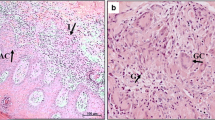Summary
In 15 patients with pityriasis rosea, we studied the evolutionary changes of the immunohistological characteristics of the secondary lesions. Many CD1a+ cells were seen in the epidermis and dermis of early lesions. In the well-developed lesions, the number of CD1a+ cells greatly increased in the dermis. In the late lesions, CD1a+ cells in the dermis significantly decreased as compared with the well-developed lesions. Early lesions showed a moderate T-cell infiltrate. In the well-developed lesions, the dermal T-cell infiltrate was dense, and the CD4 CD8 ratio was 2.9. The late lesions had a moderate T-cell infiltrate, in which the CD4 CD8 ratio significantly decreased as compared with the well-developed lesions. Thus, the relative decrease in CD4+ helper inducer cells during lesion regression, concomitant with a decrease in number of CD1a+. Langerhans cells, is in accordance with a broader concept of increased suppressor mechanisms during healing.
Similar content being viewed by others
References
Aiba S, Tagami H (1985) Immunohistological studies in pityriasis rosea: evidence for cellular immune reaction in the lesional epidermis. Arch Dermatol 121:761–765
Bhan AK, Harrist TJ, Murphy GF, Mihm MC Jr (1981) T-cell subsets and Langerhans cells in lichen planus: in situ characterization using monoclonal antibodies. Br J Dermatol 105:617–622
Bos JD, Huisman PM, Krieg SR, Faber WR (1985) Pityriasis rosea (Gibert): abnormal distribution pattern of antigen presenting cells in situ. Acta Derm Venereol (Stockh) 65:132–137
Bos JD, Garderen ID, Krieg SR, Poulter LW (1986) Different in situ distribution pattern of dendritic cells having Langerhans (T6+) and interdigitating (RFD1+) cell immunophenotype in psoriasis, atopic dermatitis, and other inflammatory dermatoses. J Invest Dermatol 87:358–361
Bunch LW, Tilley JC (1961) Pityriasis rosea: a histologic and serologic study. Arch Dermatol 84:129–136
Carr MM, Botham PA, Gawkrodger DJ, McVittie E, Ross JA, Stewart IC, Hunter JAA (1984) Early cellular reactions induced by dinitrochlorobenzene in sensitized human skin. Br J Dermatol 110:637–641
Hanau D (1986) Langerhans cells in allergic contact dermatitis: state of the art. Dermatologica 172:2–5
Happle R, Klein HM, Macher E (1986) Topical immunotherapy changes the composition of the peribulbar infiltrate in alopecia areata. Arch Dermatol Res 278:214–218
Niles HD, Klump MM (1940) Pityriasis rosea: review of the literature and report of two hundred and ninetten cases, in thirty-eight of which convalescent serum was used. Arch Dermatol Syphilol 41:265–294
Panfilis GD, Manara GC, Ferrari C, Manfredi G, Allegra F (1983) Imbalance in phenotypic expression of T cell subpopulations during different evolutionary stages of lichen planus lesions. Acta Derm Venerol (Stockh) 63:369–375
Panizzon R, Bloch PH (1982) Histology of pityriasis rosea Gigert: qualitative and quantitative light-microscopic study of 62 biopsies of 40 patients. Dermatologica 165:551–558
Pinkus H, Mehregan AH (1981) A guide to dermatohistopathology, 3rd edn. Appleton-Century-Croft, New York, pp 151–152
Silberberg I (1973) Apposition of mononuclear cells to Langerhans cells in contact allergic reactions. Acta Derm Venerol (Stockh) 53:1–12
Silberberg-Sinakin I (1980) Contact hypersensitivity and Langerhans cells. J Invest Dermatol 75:61–67
Smitt JHS, Bos JD, Hulsebosch HJ, Krieg SR (1986) In situ immunophenotyping of antigen presenting cells and T cell subsets in atopic dermatitis. Clin Exp Dermatol 11:159–168
Sugiura H, Uehara M, Shohei W (1987) An analysis of infiltrating cells in human ringworm. Acta Derm Venereol (Stockh) 67:166–169
Taylor CR, Hofman FM, Modlin RL, Rea TH (1984) Immunoperoxidase techniques applied to dermatopathology. J Cut Pathol 10:145–163
Willis CM, Young E, Brandon DR, Wilkinson JD (1986) Immunohistological and ultrastructural findings in human allergic and irritant contact dermatitis. Br J Dermatol 115:305–316
Wood GS, Warner NL, Warnke RA (1983) Anti-Leu3/T4 antibodies react with cells of monocyte/macrophage and Langerhans lineage. J Immunol 131:212–216
Author information
Authors and Affiliations
Rights and permissions
About this article
Cite this article
Sugiura, H., Miyauchi, H. & Uehara, M. Evolutionary changes of immunohistological characteristics of secondary lesions in pityriasis rosea. Arch Dermatol Res 280, 405–410 (1988). https://doi.org/10.1007/BF00429978
Received:
Issue Date:
DOI: https://doi.org/10.1007/BF00429978




